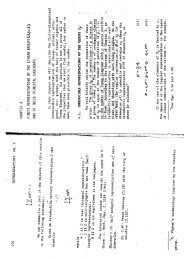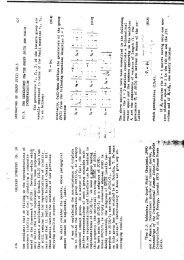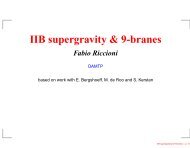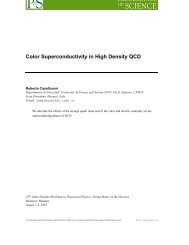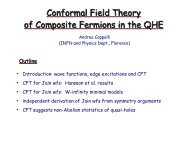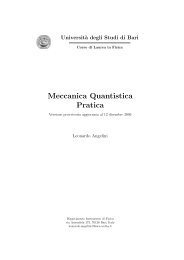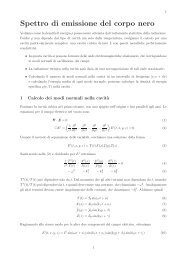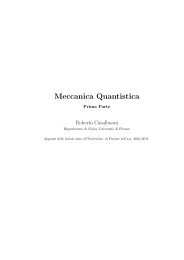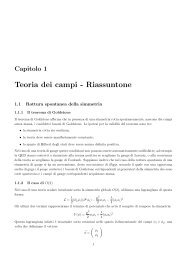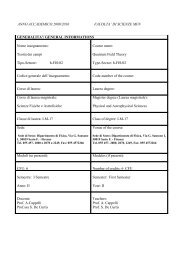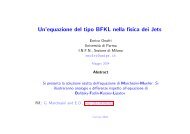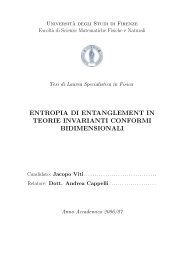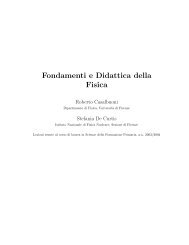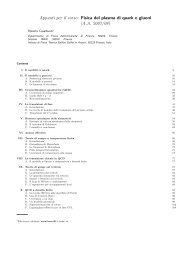arXiv:hep-ph/9804260 v2 16 Jun 1998 - Florence Theory Group
arXiv:hep-ph/9804260 v2 16 Jun 1998 - Florence Theory Group
arXiv:hep-ph/9804260 v2 16 Jun 1998 - Florence Theory Group
Create successful ePaper yourself
Turn your PDF publications into a flip-book with our unique Google optimized e-Paper software.
1. Introduction<br />
Recently there has been renewed interest in baryon states which cannot be described<br />
as simple bound states of three quarks [1, 2, 3]. One of the most prominent examples<br />
is the so–called Z + which possesses the spin and isospin quantum numbers of the Λ<br />
hyperon, however, it carries hypercharge Y = 2. When extending chiral soliton models<br />
to flavor SU(3) [4, 5] such states come about quite naturally as they are members of<br />
higher dimensional representations which do not have counterparts of equal quantum<br />
numbers in the octet or decuplet.<br />
In the context of chiral soliton models these higher dimensional representations have<br />
gained most of their recognition from the investigation of flavor symmetry breaking. Be-<br />
sides such exotic states as the Z + , the higher dimensional representations also contain<br />
states which have the spin and flavor quantum numbers of the low–lying 1+<br />
3+<br />
and 2 2<br />
baryons. One easily recognizes that flavor symmetry breaking couples states which be-<br />
long to different SU(3) representations but otherwise have identical quantum numbers.<br />
Hence these states mix with the octet and decuplet baryons as the higher dimensional<br />
representations provide a basis to obtain the exact eigenstates of the full collective Hamil-<br />
tonian [6]. As a consequence the nucleon is no longer a pure octet state but also contains<br />
sizable admixture of the corresponding members in the 10 and 27 dimensional represen-<br />
tations [7, 8]. Permissible representations are those which contain a non–strange baryon<br />
state with identical spin and isospin [9].<br />
Presumably the lightest state which does not have a counterpart of equal quantum<br />
numbers in the octet or decuplet is the above mentioned Z + . The lowest dimensional<br />
representation containing a state with the quantum numbers of the Z + is the 10. When<br />
glancing at the Young tableau of the 10, , it becomes immediately clear that such<br />
states are not simple bound states containing only three quarks. Rather they have to<br />
be interpreted as a quark–antiquark pair coupled to a three quark state. Such objects<br />
are commonly called penta–quarks. In refs [1, 2] quantitative calculations for the mass<br />
of the Z + were performed within the Skyrme model [10, 11, 12]. From fig. 2 of ref [1]<br />
one deduces that the Z + should be about 0.7GeV heavier than the nucleon. This is<br />
not too different from the estimate of ref [3] where a mass difference of 0.59GeV with<br />
respect to the nucleon was predicted. However, the latter prediction is just 100MeV<br />
above the threshold for the only accessible decay process, Z + → NK. While the result<br />
obtained in ref [1] stems from a self–contained model calculation the authors of ref [3]<br />
2



